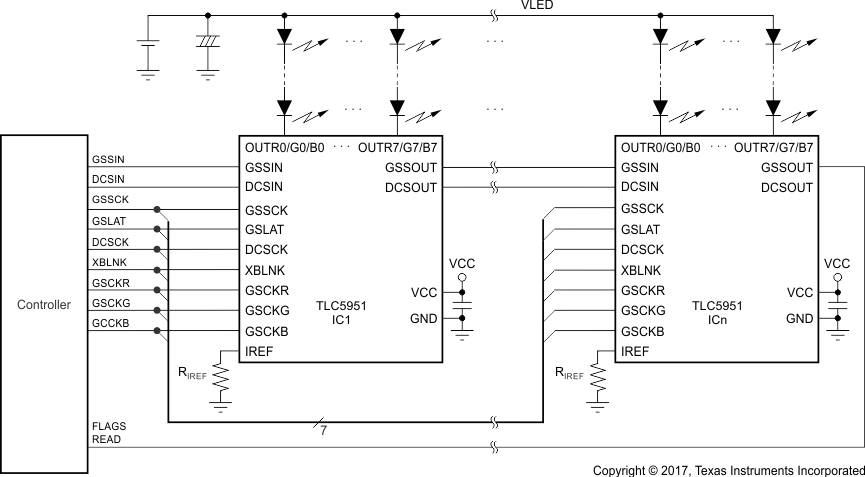SBVS127E March 2009 – July 2017 TLC5951
PRODUCTION DATA.
- 1 Features
- 2 Applications
- 3 Description
- 4 Revision History
- 5 Description (Continued)
- 6 Pin Configuration and Functions
- 7 Specifications
- 8 Parameter Measurement Information
-
9 Detailed Description
- 9.1 Overview
- 9.2 Functional Block Diagram
- 9.3 Feature Description
- 9.4
Device Functional Modes
- 9.4.1 Maximum Constant Sink-Current Value
- 9.4.2 Dot Correction (DC) Function
- 9.4.3 Global Brightness Control (BC) Function
- 9.4.4 Grayscale (GS) Function (PWM Control)
- 9.4.5 Register and Data Latch Configuration
- 9.4.6 Status Information Data (SID)
- 9.4.7 Continuous Base LOD, LSD, and TEF
- 10Device and Documentation Support
- 11Mechanical, Packaging, and Orderable Information
Package Options
Mechanical Data (Package|Pins)
Thermal pad, mechanical data (Package|Pins)
Orderable Information
1 Features
- 24-Channel Constant-Current Sink Output
- Current Capability: 40 mA
- Selectable Grayscale (GS) Control With PWM:
12-Bit (4096 Step), 10-Bit (1024 Step), 8-Bit (256 Step) - Three Independent Grayscale Clocks for Three Color Groups
- Dot Correction (DC): 7-Bit (128 Step)
- Global Brightness Control (BC) for Each Color Group: 8-Bit (256 Step)
- Auto Display Repeat Function
- Independent Data Port for GS and BC and DC Data
- Communication Path Between Each Data Port
- LED Power-Supply Voltage up to 15 V
- VCC = 3 V to 5.5 V
- Constant-Current Accuracy:
- Channel-to-Channel = ±1.5%
- Device-to-Device = ±3%
- CMOS Logic Level I/O
- Data Transfer Rate: 30 MHz
- 33-MHz Grayscale Control Clock
- Continuous Base LED-Open Detection (LOD)
- Continuous Base LED-Short Detection (LSD)
- Thermal Shutdown (TSD) With Auto Restart
- Grouped Delay to Prevent Inrush Current
- Operating Ambient Temperature: –40°C to 85°C
- Packages: HTSSOP-38, QFN-40
2 Applications
- Full-Color LED Displays
- LED Signboards
3 Description
The TLC5951 device is a 24-channel, constant-current sink driver. Each channel has an individually-adjustable, 4096-step, pulse-width modulation (PWM) grayscale (GS) brightness control and 128-step constant-current dot correction (DC). The dot correction adjusts brightness deviation between channels and other LED drivers. The output channels are grouped into three groups of eight channels. Each channel group has a 256-step global brightness control (BC) function and an individual grayscale clock input.
Device Information(1)
| PART NUMBER | PACKAGE | BODY SIZE (NOM) |
|---|---|---|
| TLC5951 | HTSSOP (38) | 12.50 mm × 6.20 mm |
| VQFN (40) | 6.00 × 6.00 mm | |
| WQFN (40) | 6.00 × 6.00 mm |
- For all available packages, see the orderable addendum at the end of the data sheet.
